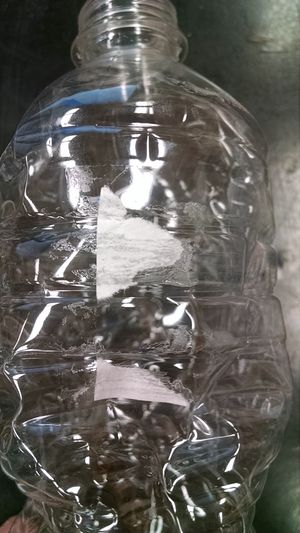THIS METHOD IS CURRENTLY A WORK IN PROGRESS
Here is outlined the method to shred, clean and dry PET at the MOST lab at Michigan Technological University. For more information on PET mechanisms please see the PET Extrusion literature review.
Shredding and Cleaning
Any PET bottles or containers which are to be to be recycled need to be ground up into smaller pieces first. This is to speed up the drying process, and also, to fit the plastic into the RecycleBot hopper.

Shredding and Cleaning: Equipment
- Shredder
- Oil-based cleaner to remove glue, see step 2. (NO WD40)
- Scissors or shears
Shredding and Cleaning: Procedure
- Peel any labels and/or different colored plastics off of the bottle.
- Remove any glue from the wrappings off using your cleaner. MOST used => TESTING IN PROGRESS.
- Rinse out your container, and dry, to remove any leftover beverages.
- Cut apart bottles and containers to fit into your shredder
- Shred the PET chunks. MOST has used a "Chipper Joe", green woodchipper and a disk shredder, from Staples. The disk shredder has worked the best so far, with consistent results.
- Collect the chunks and store somewhere cool and dry until the drying step, just as a preventative measure to moisture buidup
Recrystallization
Amorphous PET retains more water than crystalline PET, and also tends to clump together when dried. Temperaturesfor drying are intended to be for crystalline PET, rather than the amorphous form. Because of these factors, the amorphous PET which is collected from beverage bottles needs to be recrystallized first.
Currently, the reccommended method of doing this is to agitate and heat the amorphous shredded plastic at 180°F for around 1 hour [1]. This will increase the crystallinity of the plastic, and prepare it for drying.
Drying
PET needs to be dried prior to extrusion in a Recyclebot as otherwise it will undergo rapid hyrdolyzation at high temperatures, and reduce the molecular mass.
Drying: Equipment
- Convection Drying Oven (Any oven will generally work, ovens at home run off the same convection principles of heating and moving air. If using a home oven, be careful of temperatures, and be aware that there could potentially be burning plastic inside of it, if proper precautions are not taken)
- Shredded PET
- Drying tray (Any metal tray to hold the PET shreds)
Drying: Procedure
- Turn on the oven
- Evenly distribute the shredded PET in the drying tray. This exposes more surface area to enhance evaporation speed.
- Open the oven by firmly opening the door. It may take a quick jerk, but be careful not to topple it.
- Place the tray inside the oven.
- Close the oven door, firmly.
- Set the temperature on your oven to a value as shown by the table below. This table is a work in progress, please feel free to contribute and check!
- Wait for an amount of time also shown in the table above.
- Switch off the oven then carefully open the door after letting it cool for a few minutes.
- Quickly place the PET in an airtight container, such as inside two (2) layers of plastic bags that are twisted and tied shut. As long as the PET is not allowed to reabsorb water from the air, any arrangement will work.
- Store PET in a cool dry place until it is to be used. One excellent method is to place the dry PET inside a bag, which also has dessicant. This further dries the plastic, and will remove any moisture that may have accrued whilst handling it.
Temperature and Time Table
Important temperatures to be mindful of: 260°C is the melting point. 70-80°C is the glass transition temperature. The PET MUST be crystalline before this point, otherwise, temperatures much above the Tg will just clump the plastic together and cause it to degrade.
| 1 Hour | 2 Hours | 3 Hours | 4 Hours | 5 Hours | 6 Hours | |
|---|---|---|---|---|---|---|
| 82°C
Slightly above Tg |
No Change | No change | ||||
| 100°C | ||||||
| 125°C | ||||||
| 150°C | ||||||
| 175°C | ||||||
| 200°C | ||||||
| 225°C | ||||||
| 250°C | ||||||
| 275°C | ||||||
| 300°C |

